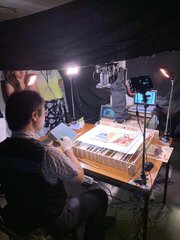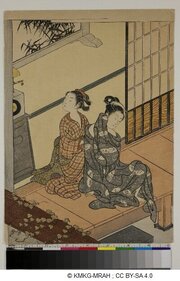-
An Interview with Nathalie Vandeperre (Curator of East Asian Collections, Royal Museums of Art and History, Belgium)October 29, 2025(Wed)
Related article → 572 Illustrated Books from the Collection of the Royal Museums of Art and History of Belgium (MRAH) have been released
Related databases → MRAH Old Books Database | MRAH Ukiyo-e Database
Background:
Nathalie Vandeperre graduated with a degree in Sinology from KU Leuven (Belgium), where she also obtained a diploma in Cultural Studies. After working for several years as a librarian in the Chinese Library and as a lecturer in the Educational Department of the MRAH, she joined the museum's East Asian Department. In 2013, she was appointed curator of the Japanese, Chinese, and Korean collections of the museum. She has curated several exhibitions and takes a particular interest in the history of the MRAH's collections.Ms. Vandeperre, thank you very much for your time today. Your academic background is in Sinology. What led you to pursue a career as a curator, and how did your interest in Japanese art develop?
Vandeperre: I studied Latin and Greek in secondary school, and when I entered university, I was eager to explore civilizations beyond the European classical world. I turned my attention to Asia but initially found it difficult to choose between Japanese and Chinese studies--I actually had no particular preference. I began studying sinology and soon developed a strong interest in Chinese art, especially painting.
At the beginning of my museum career, there were two curators--one responsible for the Chinese and Korean collections, and another one for the Japanese collection--and I was fortunate to work as an assistant to both. In 1999, I was assigned to the project of opening a Museum for Japanese Art, which truly marked the beginning of my deep engagement with the Japanese art collection. I found it absolutely fascinating.
Later, due to budgetary constraints, the two curatorial positions were merged after the curators retired, and that is how I came to oversee the entire East Asian collection. I have been very lucky in this respect.
The ARC has been collaborating with the MRAH since 2007 to digitize its extensive Japanese collection. Could you tell us how this collaboration was initiated?
Vandeperre: The collaboration with ARC was initiated by Dr. Daan Kok--now curator at the Wereldmuseum Leiden--who was our colleague in Brussels for a year. Through his efforts, Prof. Ryo Akama and his digitization team, led by Dr. Ryoko Matsuba, began the digitization of our prints in 2007. Since then, they have continued to visit twice a year--except during the COVID-19 pandemic--and over the years have managed to digitize the majority of our prints, illustrated books, historical maps, and kabuki posters.
 In your opinion, what distinguishes MRAH's Japanese collection from those held by other museums?
In your opinion, what distinguishes MRAH's Japanese collection from those held by other museums?Vandeperre: The MRAH collection comprises over 12,000 catalogued items to date, and the work continues. The first acquisitions of Japanese objects date back to the early years of the Belgian state in the 1830s and therefore reflect nearly two centuries of taste and interest in Japan.
The collection is perhaps best known today for its ukiyo-e prints; while it may not be the largest (over 7,500 prints), it is exceptional in its state of preservation. Historically, the acquisition of Japanese prints began early, in 1889 and 1905, but the collection was subsequently kept in storage for many years and thus remained largely unknown. In 1972, it was 'rediscovered' by Jack Hillier and Roger Keyes, who were preparing a major exhibition in Japan of ukiyo-e works (Zaigai ukiyo-e meisakuten, 在外浮世絵名作展). The fact that the prints were 'hidden' for so long has ultimately become our strength, as many have survived in pristine condition.
What are your thoughts on making the collection publicly accessible through the ARC's online database? How has this influenced research and engagement?
Vandeperre: From the outset, the collaboration with the ARC has supported the museum's transformation towards making the collections more accessible through digitization. The digitization work carried out by the ARC represented a huge leap forward for the Japanese collections. Each campaign resulted in a volume of images that we could never have produced on our own. The systematic interlinking of our collection database (in Dutch, French, and English) with the ARC database now enables researchers to access metadata in Japanese as well.
In the past, we only received requests--whether for loans, reproductions, or research--concerning the highlights that had been published in catalogues. Now, however, we receive a much broader range of enquiries from all over the world, which is fantastic.
Personally, I experienced the benefits of digitization during the COVID lockdowns, when it allowed me to continue cataloguing from home, resulting in the (almost) complete online prints collection. Of course, the photographs have also been used in publications, such as the catalogue for the 2016 ukiyo-e prints exhibition we organized.
Although the Japanese collection is not on permanent display, are there any upcoming exhibitions, research initiatives, or educational programs involving the collection that visitors or scholars can look forward to?
The Japanese collections are not currently on permanent display since we left the Museum of Japanese Art and the Japanese Tower in 2013. These remarkable buildings--together with the Chinese Pavilion--date from the early 20th century and require extensive renovation. In the meantime, we have been organizing temporary exhibitions and are now planning a permanent display at the Art & History Museum site, where the Japanese items are stored. In 2026, we will also collaborate on an exhibition at the Kokugakuin University Museum in Tokyo, celebrating 160 years of friendship between Belgium and Japan.
Do you have any personal favorites or highlights within the Japanese collection that you would like to share with us?
The prints by Suzuki Harunobu are among my personal favorites in the collection. When I first saw them 30 years ago, I couldn't quite appreciate their sometimes curious color combinations, but now I find this aspect the most striking. Fortunately, the collection includes many Harunobu prints with exceptionally well-preserved colors, which I try to enjoy whenever I can.
(This interview was conducted by Yinzi Emily Li)















